#east african food
Text
Asgardian, Vanir, Alfheimr, Olympus, Talokanil, Wakandan and Nidavellir cuisines in MCU HCs
Basically, Asgardians eat a mixture of Ancient Nordic, Medieval and Renaissance European foods
Since it is a colder planet in comparison to Alfheim, Asgard has a number of stews and roasts
Bread and potatoes are literally staples amongst Asgardian cuisine
Oh, and seafood is a popular culinary choice in Asgard too
One of Loki's fave foods is salmon stew btw
In MCU, Vanir cuisines are actually a mix of Central Asian, Slavic, Mongolic and Far East Siberian cuisines
Yeah Vanir culture has some nods to Central Asian, Slavic, Mongolic and Far East Siberian cultures in MCU btw
So the Vanirs LOVE dumplings, stews, LAMB AND MUTTON PREPARED IN ANY WAY, and a hunch of dairy in breakfasts
Light Elven cuisine of Alfheim basically has several nods to Mediterranean and Balkan cuisines
Basically it's got a hunch of fruits and vegetables, sweets and baked treats being VERY popular in Alfheim, and edible flowers are also popular in Alfheim too
Breakfasts are at times served in little trays of breakfast goods with fruit/floral scented tea or coffee ( imagine like an Ottoman style breakfast )
A popular street food includes hand pies of different flavours - sweet, savory, spicy, etc
Also a cultural drink of Alfheim is actually wine - as in different types of wine, not just wine made from grapes ( and the Light Elven grown ups in general LOVE to drink wine )
Dwarven cuisine in Nidavellir basically has a mix of elements of Germanic and Slavic cuisine
Being a more blacksmith geared culture, the Dwarves in general usually eat protein and dairy often as a way to sustain themselves in blacksmith relater stuff ( especially for Dwarven blacksmiths )
The Dwarves in general love a good drink - a cultural drink of Nidavellir is actually beer ( and the Dwarven grown up in general drink A LOT beer )
Wakandan cuisines defo has nods to East African and Nubian cuisines
Wakanda is rife in spices, and alcohol is popular for grown ups in Wakanda in general
Teas and coffees are popular in Wakanda too, amongst the staples of Wakanda include beans and maize
Olympus cuisines are defo have nods to Ancient Roman and Grecian cuisines
Olympus is rife with olives and fruits and vegetables - and the Olympus grown up residents in general LOVE wine
Oh and they also love cheeses ( which is a popular desert in Olympus )
Talokanil cuisines defo have nods to Mayan cuisine
Since they are an underworld kingdom, Namor's family actually managed to figure out underwater agricultural and all And underwater food supplies
Seafood is rife in Talocan, and ofc edible seaweeds and corals are amongst popular cuisines in Talocan
Amongst staples of Talokanil cuisine include maize, chili peppers and beans
And coffee and chocolate drinks are amongsr popular drinks in Talocan
🤩🤩🤩🥺🥺🥺
#asgardian cuisine#vanir cuisine#mcu nine realms#light elven cuisine#dwarven cuisine#nordic cuisine#germanic cuisine#slavic cuisine#mediterranean cuisine#olympus cuisine#talokanil cuisine#wakandan cuisine#mayan foods#east african cuisine#ancient greek cuisine#ancient roman cuisine
21 notes
·
View notes
Text
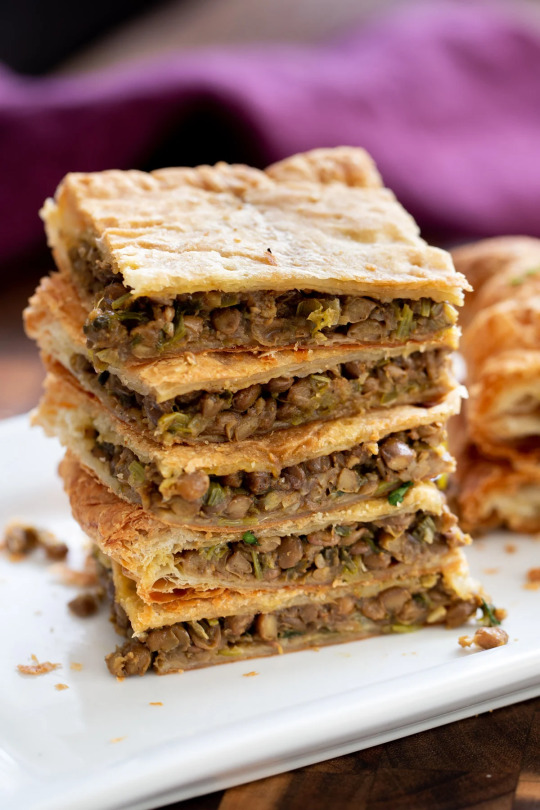
Vegan Lentil Sambusa Pie (Ethiopian Street Food)
#vegan#snacks#appetizer#ethiopian cuisine#east african cuisine#african cuisine#street food#pastry#sambusa pie#lentils#puff pastry#onion#green onion#berbere#ginger#garlic#coriander#cumin#cardamom#chili#cilantro#lemon#olive oil#black pepper#sea salt
17 notes
·
View notes
Text
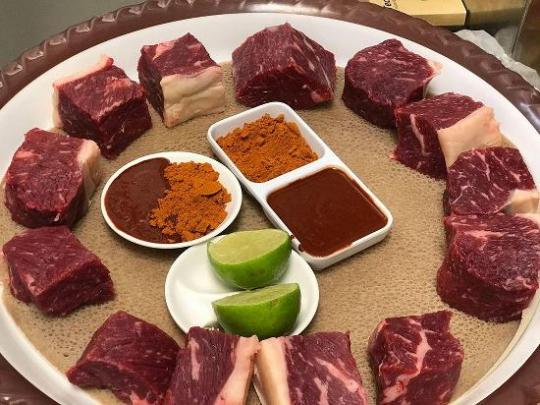


Ethiopia🇪🇹, Horn of Africa
A group Ethiopians having a raw meat lunch.
This popular dish among the Ethiopians is called "Tere siga".The meat mostly comes from the cow and served with a powdered hot spice blend called mitmita,a hot dipping sauce called "awaze", and senafich (mustard sauce).
A famous theory behind Ethiopians taste for raw meat comes from the Abyssinian-Adal war in 1600 It is believed that Ethiopians began to eat this food during the battles between Ethiopians and Somalians. It is believed that every time the Ehtiopian army prepared meat, the enemy easily fish them out and kill them in their sleep.They later came to the realization that the attàckers were using the fire that they mostly build to roast or cook the meat to locate them. To avoid being attacked in such a manner again, they chose to c0nsume their meats raw rather than roasting or c00king them.
This was later incorporated into Ethiopian culture and developed into a popular delicacy in honor of the occasion.

#african#afrakan#kemetic dreams#africans#brownskin#brown skin#afrakans#african culture#tera sigma#ethiopian#ethiopia#ethical food#ethical concerns#north east africa#east africa
20 notes
·
View notes
Text
it’s very fun to have multiple cultures bc as a child i used to add peanut butter to the chipati my mom would cook and she would be eerily concerned bc she thought the idea of it together sounded both gross and creative
#also i can’t stand the taste of it together anymore#i think it’s better when the toppings are plain things like beans or spinach#but also most typical east african foods where my mom is from weren’t very sweet bc sugar was#expensive there so i see why she found it odd now lol#mandazi maybe but that was more for parties bc it took all day to make
2 notes
·
View notes
Note
if you could take a class on anything, what would it be?
proffession cooking - particularly asian and african food!
#im making thai green curry tonight ^_^#but would love to know more about asian and african food becuase i know little of the history or differnces#especially in africa#im pretty good at east asain foods :) for a brit at least
1 note
·
View note
Text
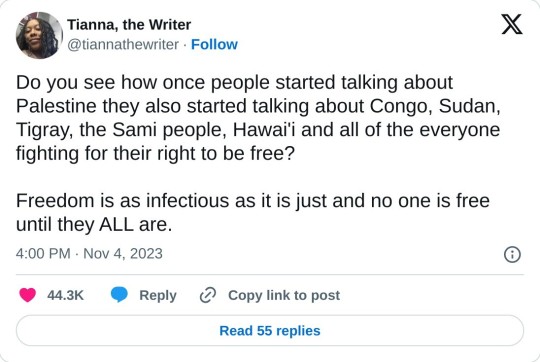
People & countries mentioned in the thread:
DR Congo - M23, Cobalt
Darfur, Sudan - International Criminal Court, CNN, BBC (Overview); Twitter Explanation on Sudan
Tigray - Human Rights Watch (Ethnic Cleansing Report)
the Sámi people - IWGIA, Euronews
Hawai'i - IWGIA
Syria - Amnesty International
Kashmir- Amnesty Summary (PDF), Wikipedia (Jammu and Kashmir), Human Rights Watch (2022)
Iran - Human Rights Watch, Morality Police (Mahsa/Jina Amini - Al Jazeera, Wikipedia)
Uyghurs - Uyghur Human Rights Project (UHRP) Q&A, Wikipedia, Al Jazeera, UN Report
Tibetans - SaveTibet.org, United Nations
Yazidi people - Wikipedia, United Nations
West Papua - Free West Papua, Genocide Watch
Yemen - Human Rights Watch (Saudi border guards kill migrants), Carrd
Sri Lanka (Tamils) - Amnesty International, Human Rights Watch
Afghans in Pakistan - Al Jazeera, NPR
Ongoing Edits: more from the notes / me
Armenians in Nagorno-Karabakh/Azerbaijan (Artsakh) - Global Conflict Tracker ("Nagorno-Karabakh Conflict"), Council on Foreign Relations, Human Rights Watch (Azerbaijan overview), Armenian Food Bank
Baháʼís in Iran - Bahá'í International Community, Amnesty, Wikipedia, Minority Rights Group International
Kafala System in the Middle East - Council on Foreign Relations, Migrant Rights
Rohingya - Human Rights Watch, UNHCR, Al Jazeera, UNICEF
Montagnards (Vietnam Highlands) - World Without Genocide, Montagnard Human Rights Organization (MHRO), VOA News
Ukraine - Human Rights Watch (April 2022), Support Ukraine Now (SUN), Ukraine Website, Schools & Education (HRW), Dnieper River advancement (Nov. 15, 2023 - Ap News)
Reblogs with Links / From Others
Indigenous Ppl of Canada, Cambodia, Mexico, Colombia
Libya
Armenia Reblog 1, Armenia Reblog 2
Armenia, Ukraine, Central African Republic, Indigenous Americans, Black ppl (US)
Rohingya (Myanmar)
More Hawai'i Links from @sageisnazty - Ka Lahui Hawaii, Nation of Hawai'i on Soverignty, Rejected Apology Resolution
From @rodeodeparis: Assyrian Policy Institute, Free Yezidi
From @is-this-a-cool-url: North American Manipur Tribal Association (NAMTA)
From @dougielombax & compiled by @azhdakha: Assyrians & Yazidis
West Sahara conflict
Last Updated: Feb. 19th, 2024 (If I missed smth before this, feel free to @ me to add it)
#resources#important#congo#sudan#tigray#sámi#hawai'i#syria#kashmir#iran#uyghurs#china#tibetans#yazidi#west papua#yemen#sri lanka#afghans in pakistan#pakistan#human rights#palestine#twitter#lmk if there's a better reource or I linked smth wrong. I am very tired#my posts#genocide#social justice#nagorno karabakh#Bahá'í#kafala system#qatar
45K notes
·
View notes
Text
This little Ethiopian supplies store opened in town and they have the Berbere spice mix so I have to learn some Ethiopian veggie dishes I have to, because they're so delicious and gives me a reason to get a big bag of the stuff.
#Kraay talks#agh all this talk makes me want to order from the East-African place again too#seriously if you get the chance#try Ethiopian/Eritrean food it is legit so good
1 note
·
View note
Text
Hady's Restaurant International Cuisine
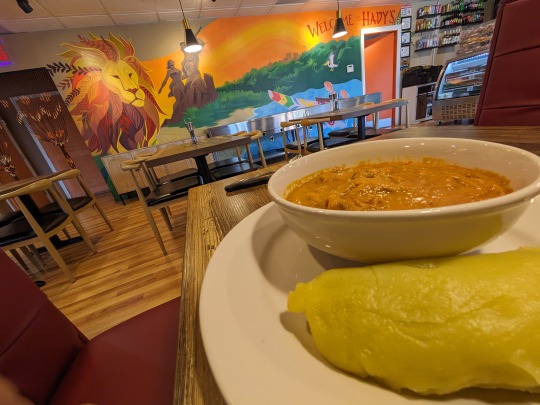
I imagine there's a few folks who find Hady's Restaurant International Cuisine intimidating. Its location embedded within the residential streets of East Martin, feeling miles away from the commonly traveled streets of downtown. A menu that does not seem to temper its flavors or dishes to appease those who are unfamiliar. It were for those reasons I was so interested in visiting the place.
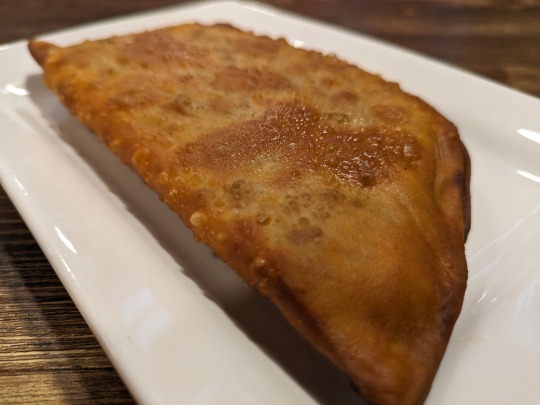
Hady's caught my attention right before the pandemic took hold of our daily lives in early 2020. To my surprise, despite the eatery being a new restaurant and serving a cuisine that is not completely embraced by the surrounding city, it was able to navigate through the hardship of COVID.
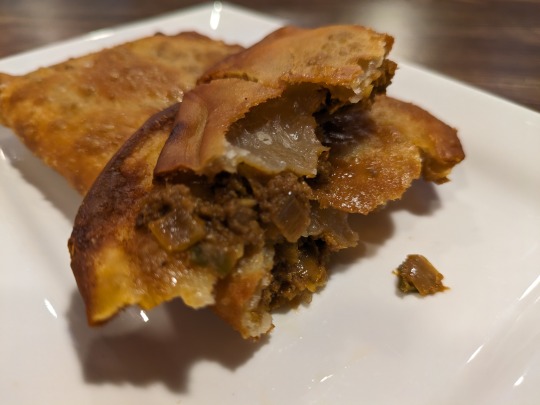
Its all too easy for me to think of African cuisine as one big monolithic style of cooking that covers the entire continent. But Hady's is a good reminder that each African country and region has a flavors all their own. With a menu serves dishes that span from Senegal to Niger, the restaurant truly lives up to its international moniker. From Senegal, Fish Fataya is Hady's rendition of a popular street food. Freshly fried and with a distinct fish taste, this hand pie provided an introduction to Senegalese tastes in a familiar deep fried package.
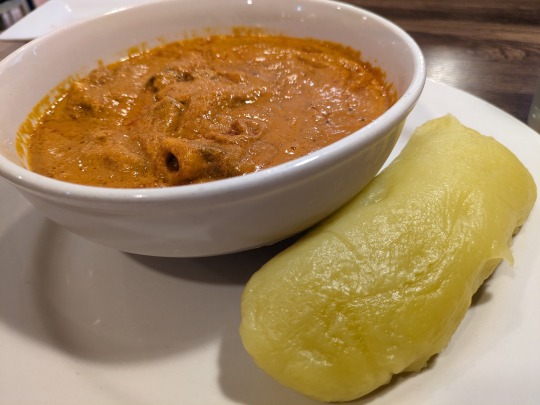
Years ago I was exploring a local African grocery and found a box of fufu. When we got around to cooking it, it was bland and an awkward gritty texture. Figured dish was that way to ensure that the stews typically served with fufu would be the focal point. But when I had Hady's fufu, I was surprised to be treated to a smoother and tasty version of fufu. Still not overwhelming with flavor, it was some similar to mashed potatoes.
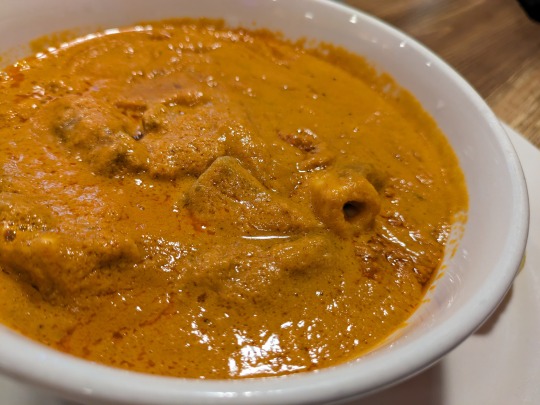
While I enjoyed the fufu, it really is just a delivery method for the lamb peanut better stew. A thick and rich peanut butter soup, touched with a bit of spice. The heavy peanut butter taste paired well with the gamy lamb. The first half of my meal, I attempted to perfect my fufu scooping technique but more often then not got messy, so I resorted to a fork and chewing.
Grateful that Hady is in Raleigh giving a chance to experience African food.
Hady's Restaurant International Cuisine
https://hadyinternational.com/
717 E Martin St Suite 199, Raleigh, NC 27601
0 notes
Text
#Wheat Flour#All-Purpose Flour#Food Wholesaler#Reesha General Trading#International Food#CIF Price#East African Ports#West African Ports#Turkey Origin#25kg Packing#50kg Packing#Container Shipping#MOQ 5fcl#Djibouti Port#Mogadishu Somalia#Berbera Somaliland#Dar es Salaam Tanzania#Mombasa Kenya#20ft Container Shipping of 27 Tons Wheat Flour#Top Turkish Wheat Flour Supplier - Reesha General Trading#Versatile All-Purpose Wheat Flour from Turkey#Reesha General Trading - Reliable Wheat Flour Exporter#Bulk Purchase - Wheat Flour for Distributors and Retailers#Best Deals on All-Purpose Wheat Flour CIF to African Ports#Top Quality Wheat Flour for African Markets#Reesha General Trading - Your Trusted Wheat Flour Partner
0 notes
Text
White Chocolate Biscoff Puff Pastry Braid
White Chocolate Biscoff Puff Pastry Braid
Ingredients400g puff pastry, defrosted100g Biscoff spread150g White chocolate bar1 eggSliced almonds, for garnish1 tsp granulated sugar
MethodPreheat oven to 200C. Prepare a baking tray with baking paper.Place the thawed puff pastry on the baking paper.Visually divide the pastry into 3 sections. Use a knife to make 10 equal strips on the 2 outer…

View On WordPress
#authentic#Biscoff desserts#chocolate#Dessert#East puff pastry desserts#easy#Easy puff pastry desserts#food#fresh#homemade#pastry braid desserts#simple#south African#white chocolate pastry
1 note
·
View note
Text
In the current epidemic of rich Western women who cannot “choose” to eat, we see the continuation of an older, poorer tradition of women’s relation to food. Modern Western female dieting descends from a long history. Women have always had to eat differently from men: less and worse. In Hellenistic Rome, reports classicist Sarah B. Pomeroy, boys were rationed sixteen measures of meal to twelve measures allotted to girls. In medieval France, according to historian John Boswell, women received two thirds of the grain allocated to men. Throughout history, when there is only so much to eat, women get little, or none: A common explanation among anthropologists for female infanticide is that food shortage provokes it. According to UN publications, where hunger goes, women meet it first: In Bangladesh and Botswana, female infants die more frequently than male, and girls are more often malnourished, because they are given smaller portions. In Turkey, India, Pakistan, North Africa, and the Middle East, men get the lion’s share of what food there is, regardless of women’s caloric needs. “It is not the caloric value of work which is represented in the patterns of food consumption” of men in relation to women in North Africa, “nor is it a question of physiological needs…. Rather these patterns tend to guarantee priority rights to the ‘important’ members of society, that is, adult men.” In Morocco, if women are guests, “they will swear they have eaten already” or that they are not hungry. “Small girls soon learn to offer their share to visitors, to refuse meat and deny hunger.” A North African woman described by anthropologist Vanessa Mahler assured her fellow diners that “she preferred bones to meat.” Men, however, Mahler reports, “are supposed to be exempt from facing scarcity which is shared out among women and children.”
“Third World countries provide examples of undernourished female and well-nourished male children, where what food there is goes to the boys of the family,” a UN report testifies. Two thirds of women in Asia, half of all women in Africa, and a sixth of Latin American women are anemic—through lack of food. Fifty percent more Nepali women than men go blind from lack of food. Cross-culturally, men receive hot meals, more protein, and the first helpings of a dish, while women eat the cooling leftovers, often having to use deceit and cunning to get enough to eat. “Moreover, what food they do receive is consistently less nutritious.”
This pattern is not restricted to the Third World: Most Western women alive today can recall versions of it at their mothers’ or grandmothers’ table: British miners’ wives eating the grease-soaked bread left over after their husbands had eaten the meat; Italian and Jewish wives taking the part of the bird no one else would want.
These patterns of behavior are standard in the affluent West today, perpetuated by the culture of female caloric self-deprivation. A generation ago, the justification for this traditional apportioning shifted: Women still went without, ate leftovers, hoarded food, used deceit to get it—but blamed themselves. Our mothers still exiled themselves from the family circle that was eating cake with silver cutlery off Wedgwood china, and we would come upon them in the kitchen, furtively devouring the remains. The traditional pattern was cloaked in modern shame, but otherwise changed little. Weight control became its rationale once natural inferiority went out of fashion.
— Naomi Wolf (1990) The Beauty Myth
#hunger#long post#naomi wolf#the beauty myth#radblr#radfem#radical feminism#radfem safe#radical feminist safe#!!!
802 notes
·
View notes
Text
in addition to being prone to an obvious naturalistic fallacy, the oft-repeated claim that various supplements / herbs / botanicals are being somehow suppressed by pharmaceutical interests seeking to protect their own profits ('they would rather sell you a pill') belies a clear misunderstanding of the relationship between 'industrial' pharmacology and plant matter. bioprospecting, the search for plants and molecular components of plants that can be developed into commercial products, has been one of the economic motivations and rationalisations for european colonialism and imperialism since the so-called 'age of exploration'. state-funded bioprospectors specifically sought 'exotic' plants that could be imported to europe and sold as food or materia medica—often both, as in the cases of coffee or chocolate—or, even better, cultivated in 'economic' botanical gardens attached to universities, medical schools, or royal palaces and scientific institutions.
this fundamental attitude toward the knowledge systems and medical practices of colonised people—the position, characterising eg much 'ethnobotany', that such knowledge is a resource for imperialist powers and pharmaceutical manufacturers to mine and profit from—is not some kind of bygone historical relic. for example, since the 1880s companies including pfizer, bristol-myers squibb, and unilever have sought to create pharmaceuticals from african medicinal plants, such as strophanthus, cryptolepis, and grains of paradise. in india, state-created databases of valuable 'traditional' medicines have appeared partly in response to a revival of bioprospecting since the 1980s, in an increasingly bureaucratised form characterised by profit-sharing agreements between scientists and local communities that has nonetheless been referred to as "biocapitalism". a 1990 paper published in the proceedings of the novartis foundation symposium (then the ciba foundation symposium) spelled out this form of epistemic colonialism quite bluntly:
Ethnobotany, ethnomedicine, folk medicine and traditional medicine can provide information that is useful as a 'pre-screen' to select plants for experimental pharmacological studies.
there is no inherent oppositional relationship between pharmaceutical industry and 'natural' or plant-based cures. there are of course plenty of examples of bioprospecting that failed to translate into consumer markets: ginseng, introduced to europe in the 17th century through the mercantile system and the east india company, found only limited success in european pharmacology. and there are cases in which knowledge with potential market value has actually been suppressed for other reasons: the peacock flower, used as an abortifacient in the west indies, was 'discovered' by colonial bioprospectors in the 18th century; the plant itself moved easily to europe, but knowledge of its use in reproductive medicine became the subject of a "culturally cultivated ignorance," resulting from a combination of funding priorities, national policies, colonial trade patterns, gender politics, and the functioning of scientific institutions. this form of knowledge suppression was never the result of a conflict wherein bioprospectors or pharmacists viewed the peacock flower as a threat to their own profits; on the contrary, they essentially sacrificed potential financial benefits as a result of the political and social factors that made abortifacient knowledge 'unknowable' in certain state and commercial contexts.
exploitation of plant matter in pharmacology is not a frictionless or infallible process. but the sort of conspiratorial thinking that attempts to position plant therapeutics and 'big pharma' as oppositional or competitive forces is an ahistorical and opportunistic example of appealing to nominally anti-capitalist rhetoric without any deeper understanding of the actual mechanisms of capitalism and colonialism at play. this is of course true whether or not the person making such claims has any personal financial stake in them, though it is of course also true that, often, they do hold such stakes.
535 notes
·
View notes
Note
When you tag things “#abolition”, what are you referring to? Abolishing what?
Prisons, generally. Though not just physical walls of formal prisons, but also captivity, carcerality, and carceral thinking. Including migrant detention; national border fences; indentured servitude; inability to move due to, and labor coerced through, debt; de facto imprisonment or isolation of the disabled or medically pathologized; privatization and enclosure of land; categories of “criminality"; etc.
In favor of other, better lives and futures.
Specifically, I am grateful to have learned from the work of these people:
Ruth Wilson Gilmore on “abolition geography”.
Katherine McKittrick on "imaginative geographies"; emotional engagement with place/landscape; legacy of imperialism/slavery in conceptions of physical space and in devaluation of other-than-human lifeforms; escaping enclosure; plantation “afterlives” and how plantation logics continue to thrive in contemporary structures/institutions like cities, prisons, etc.; a “range of rebellions” through collaborative acts, refusal of the dominant order, and subversion through joy and autonomy.
Macarena Gomez-Barris on landscapes as “sacrifice zones”; people condemned to live in resource extraction colonies deemed as acceptable losses; place-making and ecological consciousness; and how “the enclosure, the plantation, the ship, and the prison” are analogous spaces of captivity.
Liat Ben-Moshe on disability; informal institutionalization and incarceration of disabled people through physical limitation, social ostracization, denial of aid, and institutional disavowal; and "letting go of hegemonic knowledge of crime”.
Achille Mbembe on co-existence and care; respect for other-than-human lifeforms; "necropolitics" and bare life/death; African cosmologies; historical evolution of chattel slavery into contemporary institutions through control over food, space, and definitions of life/land; the “explicit kinship between plantation slavery, colonial predation, and contemporary resource extraction” and modern institutions.
Robin Maynard on "generative refusal"; solidarity; shared experiences among homeless, incarcerated, disabled, Indigenous, Black communities; to "build community with" those who you are told to disregard in order "to re-imagine" worlds; envisioning, imagining, and then manifesting those alternative futures which are "already" here and alive.
Leniqueca Welcome on Caribbean world-making; "the apocalyptic temporality" of environmental disasters and the colonial denial of possible "revolutionary futures"; limits of reformism; "infrastructures of liberation at the end of the world."; "abolition is a practice oriented toward the full realization of decolonization, postnationalism, decarceration, and environmental sustainability."
Stefano Harney and Fred Moten on “the undercommons”; fugitivity; dis-order in academia and institutions; and sharing of knowledge.
AM Kanngieser on "deep listening"; “refusal as pedagogy”; and “attunement and attentiveness” in the face of “incomprehensible” and immense “loss of people and ecologies to capitalist brutalities”.
Lisa Lowe on "the intimacies of four continents" and how British politicians and planters feared that official legal abolition of chattel slavery would endanger Caribbean plantation profits, so they devised ways to import South Asian and East Asian laborers.
Ariella Aisha Azoulay on “rehearsals with others’.
Phil Neel on p0lice departments purposely targeting the poor as a way to raise municipal funds; the "suburbanization of poverty" especially in the Great Lakes region; the rise of lucrative "logistics empires" (warehousing, online order delivery, tech industries) at the edges of major urban agglomerations in "progressive" cities like Seattle dependent on "archipelagos" of poverty; and the relationship between job loss, homelessness, gentrification, and these logistics cities.
Alison Mountz on migrant detention; "carceral archipelagoes"; and the “death of asylum”.
Pedro Neves Marques on “one planet with many worlds inside it”; “parallel futures” of Indigenous, Black, disenfranchised communities/cosmologies; and how imperial/nationalist institutions try to foreclose or prevent other possible futures by purposely obscuring or destroying histories, cosmologies, etc.
Peter Redfield on the early twentieth-century French penal colony in tropical Guiana/Guyana; the prison's invocation of racist civilization/savagery mythologies; and its effects on locals.
Iain Chambers on racism of borders; obscured and/or forgotten lives of migrants; and disrupting modernity.
Paulo Tavares on colonial architecture; nationalist myth-making; and erasure of histories of Indigenous dispossession.
Elizabeth Povinelli on "geontopower"; imperial control over "life and death"; how imperial/nationalist formalization of private landownership and commodities relies on rigid definitions of dynamic ecosystems.
Kodwo Eshun on African cosmologies and futures; “the colonial present”; and imperialist/nationalist use of “preemptive” and “predictive” power to control the official storytelling/narrative of history and to destroy alternatives.
Tim Edensor on urban "ghosts" and “industrial ruins”; searching for the “gaps” and “silences” in the official narratives of nations/institutions, to pay attention to the histories, voices, lives obscured in formal accounts.
Megan Ybarra on place-making; "site fights"; solidarity and defiance of migrant detention; and geography of abolition/incarceration.
Sophie Sapp Moore on resistance, marronage, and "forms of counterplantation life"; "plantation worlds" which continue to live in contemporary industrial resource extraction and dispossession.
Deborah Cowen on “infrastructures of empire and resistance”; imperial/nationalist control of place/space; spaces of criminality and "making a life at the edge" of the law; “fugitive infrastructures”.
Elizabeth DeLoughrey on indentured labor; the role of plants, food, and botany in enslaved and fugitive communities; the nineteenth-century British Empire's labor in the South Pacific and Caribbean; the twentieth-century United States mistreatment of the South Pacific; and the role of tropical islands as "laboratories" and isolated open-air prisons for Britain and the US.
Dixa Ramirez D’Oleo on “remaining open to the gifts of the nonhuman” ecosystems; hinterlands and peripheries of empires; attentiveness to hidden landscapes/histories; defying surveillance; and building a world of mutually-flourishing companions.
Leanne Betasamosake Simpson on reciprocity; Indigenous pedagogy; abolitionism in Canada; camaraderie; solidarity; and “life-affirming” environmental relationships.
Anand Yang on "forgotten histories of Indian convicts in colonial Southeast Asia" and how the British Empire deported South Asian political prisoners to the region to simultaneously separate activists from their communities while forcing them into labor.
Sylvia Wynter on the “plot”; resisting the plantation; "plantation archipelagos"; and the “revolutionary demand for happiness”.
Pelin Tan on “exiled foods”; food sovereignty; building affirmative care networks in the face of detention, forced migration, and exile; connections between military rule, surveillance, industrial monocrop agriculture, and resource extraction; the “entanglement of solidarity” and ethics of feeding each other.
Avery Gordon on haunting; spectrality; the “death sentence” of being deemed “social waste” and being considered someone “without future”; "refusing" to participate; "escaping hell" and “living apart” by striking, squatting, resisting; cultivating "the many-headed hydra of the revolutionary Black Atlantic"; alternative, utopian, subjugated worldviews; despite attempts to destroy these futures, manifesting these better worlds, imagining them as "already here, alive, present."
Jasbir Puar on disability; debilitation; how the control of fences, borders, movement, and time management constitute conditions of de facto imprisonment; institutional control of illness/health as a weapon to "debilitate" people; how debt and chronic illness doom us to a “slow death”.
Kanwal Hameed and Katie Natanel on "liberation pedagogy"; sharing of knowledge, education, subversion of colonial legacy in universities; "anticolonial feminisms"; and “spaces of solidarity, revolt, retreat, and release”.
#abolition#multispecies#ecologies#ecology#abolition post#haunting#geographic imaginaries#tidalectics#debt and debt colonies
2K notes
·
View notes
Text
Have some critical thinking, please and thank you
is it just me... or do Israel's government's supporters have the same vibe as:
"Actually, it doesn't matter that Jeffery Dahmer tortured and killed people, since he's gay, which makes him a saint actually. Those boys should have just gone to the police, not that that's necessary, since, again, he's a saint."
Like... that's literally the shit I hear every time you ask "So... why, again, was is necessary to kill tens of thousands of people?" and they SCREAM antisemitism, even when Holocaust survivors are saying that Gazans are facing similar conditions that they faced in the camps. Even when Jewish people chain themselves to the White House fence, ya'll will STILL talk over them.
When people say "Don't talk over minority groups, listen to what THEY have to say." THIS is what they mean. Don't talk over a minority group that is protesting the systematic torture and killing of another minority group.
It is really quite simple. You don't accidentally get taken to court for genocide accusations. You don't accidentally snipe CHILDREN. You don't accidentally murder over 30,000 people. You don't accidentally attack civilians when they try to get food.
When native people, Irish people, and South Africans ALL are on the same side, the one that says, "Stop killing Muslims (again, by the tens of thousands) and give the native people their land back" and you are AGAINST that side, you are pro-colonialism. Hell, Israelis are protesting their OWN government. Even under the threat of torture, they STILL get up and protest. Why can't you?
You are a reflection of your ancestors that took native people's land before you, and you will never be the end of your family's line of thinking UNTIL you question your own beliefs. UNTIL you decide that you aren't going to call children "fodder" and are going to let go of the idea that America just NEEDS it's grubby hands in the middle east. until you let go of those ideas, until you let go of your hate for Muslims, you will NEVER be anything more than a reflection of your colonizer ancestors.
The fact that you cheer on the death of tens of thousands of people, should be enough for you to know that. The fact that you proudly say that Muslims are "inherently violent" should be enough for you to know that you only stand up for minorities when it suits YOUR needs. You will ONLY have BLM in your bio if it goes with your blog's aesthetic. You will NEVER, in any meaningful way, be an ally.
Not to mention, you make Jewish people look like bloodthirsty monsters, like holy hell, is this a smear campaign or what???
#free palestine#palestine#israel#politics#us politics#world politics#islamophobia#colonialism#imperialism#us imperialism#antizionism#nakba
344 notes
·
View notes
Text
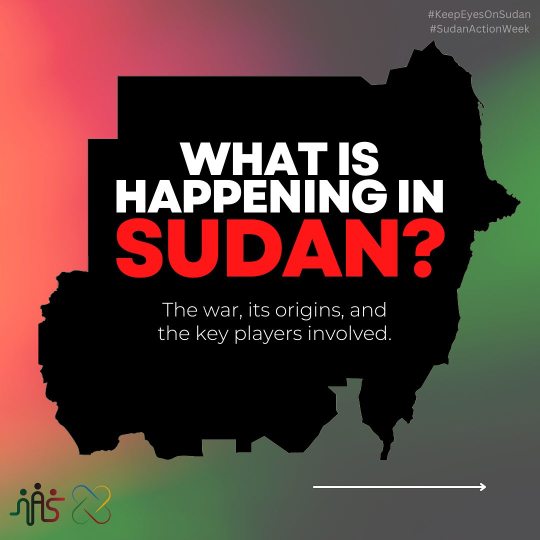
Via NasAlSudan
December 17 2023. #KeepEyesOnSudan #SudanActionWeek
Swipe through to build a foundational understanding of the war, its origins, and the key players involved. For actionable ways to support those in Sudan, check the link in our bio. Stay tuned for more posts this week.

Transcript:
National:
On April 15, a war broke out in Sudan's capital city of Khartoum between the Sudanese Armed Forces (SAF), and a paramilitary group known as the Rapid Support Forces (RSF).
Since then, eight months of conflict has led to major destruction of Khartoum's infrastructure, the most developed region of Sudan, with fighting also spreading to the regions of Darfur in the west and Kordofan in the south.
Civilians in conflict zones have been forcibly displaced, under threat of physical and sexual violence, particularly by the RSF, which has looted, destroyed, and settled in people's homes.
Regional:
In the western region of Darfur, a campaign of ethnic cleansing is being carried out by the RSF targeting the Masalit tribe. Allegations of genocide have been levied against the RSF.
Reports have just emerged that fighting has now spread to Wad Madani in Al Gezira state, which houses nearly 500,000 IDPs from Khartoum.
Key figures:
Abdel Fattah al Burhan Head of SAF
Omar El-Bashir Deposed Dictator of Sudan
Mohamed Dagalo (Hemidti) Head of RSF

Transcript:
Sudan: the war in numbers
A humanitarian "catastrophe"
24.7 million in need of critical humanitarian assistance
70-80% of hospitals out of service in conflict areas
19 million children are out of school
20.3 million people acutely food insecure. 4.9 million facing emergency hunger levels
6.7 million displaced [5.4 million IDPS, 1.3 million refugees]
7,000+ cholera cases an increase of +136% over the past month
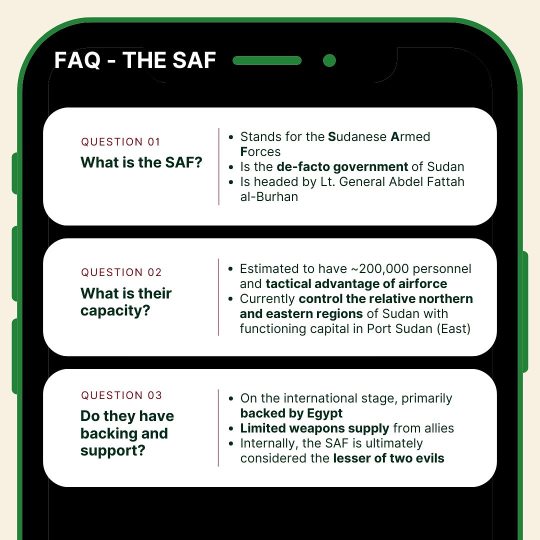
Transcript:
FAQ - THE SAF
QUESTION 01: What is the SAF?
Stands for the Sudanese Armed Forces
Is the de-facto government of Sudan
Is headed by Lt. General Abdel Fattah al-Burhan
QUESTION 02 What is their capacity?
Estimated to have ~200,000 personnel and tactical advantage of airforce
Currently control the relative northern and eastern regions of Sudan with functioning capital in Port Sudan (East)
QUESTION 03 Do they have backing and support?
On the international stage, primarily backed by Egypt
Limited weapons supply from allies
Internally, the SAF is ultimately considered the lesser of two evils
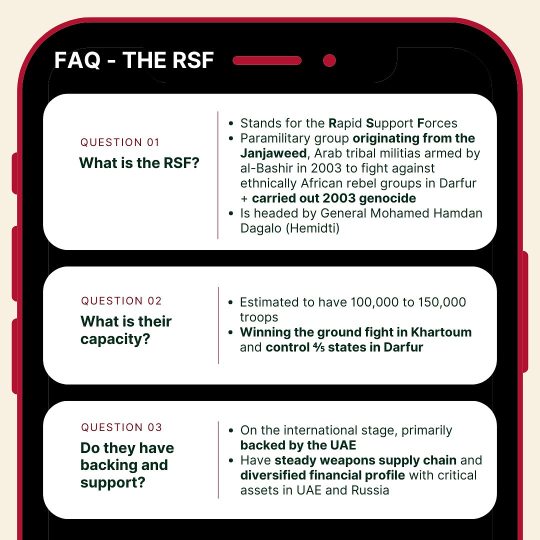
Transcript:
FAQ - THE RSF
QUESTION 01 What is the RSF?
Stands for the Rapid Support Forces
Paramilitary group originating from the Janjaweed, Arab tribal militias armed by al-Bashir in 2003 to fight against ethnically African rebel groups in Darfur + carried out 2003 genocide
Is headed by General Mohamed Hamdan Dagalo (Hemidti)
QUESTION 02 What is their capacity?
Estimated to have 100,000 to 150,000 troops
Winning the ground fight in Khartoum and control 4/5 states in Darfur
QUESTION 03 Do they have backing and support?
On the international stage, primarily backed by the UAE
Have steady weapons supply chain and diversified financial profile with critical assets in UAE and Russia
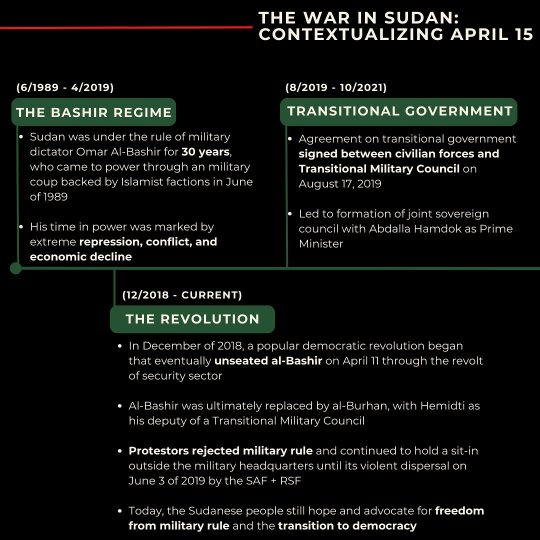
Transcript:
THE WAR IN SUDAN: CONTEXTUALIZING APRIL 15
(6/1989 - 4/2019) THE BASHIR REGIME
Sudan was under the rule of military dictator Omar Al-Bashir for 30 years, who came to power through an military coup backed by Islamist factions in June of 1989
His time in power was marked by extreme repression, conflict, and economic decline
(12/2018 CURRENT) THE REVOLUTION
In December of 2018, a popular democratic revolution began that eventually unseated al-Bashir on April 11 through the revolt of security sector
Al-Bashir was ultimately replaced by al-Burhan, with Hemidti as his deputy of a Transitional Military Council
Protestors rejected military rule and continued to hold a sit-in outside the military headquarters until its violent dispersal on June 3 of 2019 by the SAF + RSF
Today, the Sudanese people still hope and advocate for freedom from military rule and the transition to democracy
(8/2019-10/2021) TRANSITIONAL GOVERNMENT
Agreement on transitional government signed between civilian forces and Transitional Military Council on August 17, 2019
Led to formation of joint sovereign council with Abdalla Hamdok as Prime Minister

Transcript:
(10/2021 CURRENT)THE OCT 25, 2021 COUP
Burhan and Hemidti carry out military coup overthrowing civilian counterparts
They draw power from international legitimization despite prolonged mass protests in Sudan
(12/2022) THE FRAMEWORK AGREEMENT
In December of 2022, civilians put out a framework agreement signed onto by SAF and RSF + civil society groups and political parties meant to return to a transitional government
Key part of agreement: question of integration of the RSF into the SAF
Parties were to finalize the agreement and sign on April 1; RSF and SAF ultimately disagreed on integration timeline with RSF wanting 10 years and the SAF wanting 2
(12/2022-4/2023) THE LEAD UP TO APRIL 15
As framework agreement negotiations failed, both parties began mobilizing troops in capital of Khartoum in days leading up to April 15
Residents of Khartoum awoke to the sounds of gunfire on April 15 and by noon, the RSF had seized Meroe airport in the Northern state
Conflict today considered a battle for power between the two generals they are too far in to walk back

Transcript:
FRAMING ALLIANCES
Sudanese Armed Forces (SAF):
Egypt
Israel (Foreign Ministry)
Islamists
Iran
Saudi Arabia
Ukraine (SOF)
Armed Groups
Rebel groups that had taken up arms against the central government in the Bashir Era are forced to ally with the SAF due to the RSF's ethnic cleansing campaign. They include:
Justice and Equality Movement (Gibril Ibrahim)
Sudan Liberation Movement/Army (Minni Minawi)
Gathering of Sudan Liberation Forces (Abdallah Yahya)
Rapid Support Forces (RSF):
Israel (Mossad)
Libya (Khalifa Haftar)
United Arab Emirates
Central African Republic
Russia (Wagner Group)
Chad
Arab Tribal Leaders
Arab tribal leaders across the Western region of Darfur have pledged their allegiance and support to the RSF, with members of the tribes across the Sahel crossing into Sudan to join the RSF's assault as well.
Key tribes include: Beni Halba, Tarjam, Habaniya, Fallata, Misseriya, Taaysha, Rizeigat
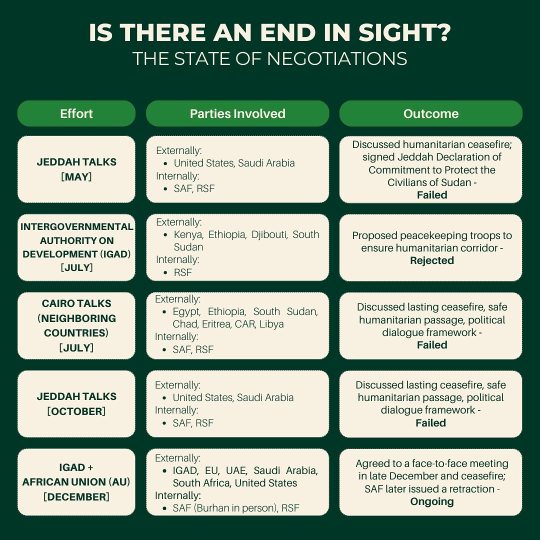
Transcript:
IS THERE AN END IN SIGHT?
THE STATE OF NEGOTIATIONS
Effort: JEDDAH TALKS [MAY]
Parties involved: Externally: United States, Saudi Arabia Internally: SAF, RSF
Outcome: Discussed humanitarian ceasefire; signed Jeddah Declaration of Commitment to Protect the Civilians of Sudan - Failed
Effort: INTERGOVERNMENTAL AUTHORITY ON DEVELOPMENT (IGAD) [JULY]
Parties Involved: Externally: Kenya, Ethiopia, Djibouti, South Sudan Internally: RSF
Outcome: Proposed peacekeeping troops to ensure humanitarian corridor - Rejected
Effort: CAIRO TALKS (NEIGHBORING COUNTRIES) [JULY]
Parties Involved: Externally: Egypt, Ethiopia, South Sudan, Chad, Eritrea, CAR, Libya Internally: SAF, RSF
Outcome: Discussed lasting ceasefire, safe humanitarian passage, political dialogue framework - Failed
Effort: JEDDAH TALKS [OCTOBER]
Parties Involved: Externally: United States, Saudi Arabia Internally: SAF, RSF
Outcome: Discussed lasting ceasefire, safe humanitarian passage, political dialogue framework - Failed
Effort: IGAD + AFRICAN UNION (AU) [DECEMBER]
Parties Involved: Externally: IGAD, EU, UAE, Saudi Arabia, South Africa, United States Internally: SAF (Burhan in person), RSF
Outcome: Agreed to a face-to-face meeting in late December and ceasefire; SAF later issued a retraction - Ongoing
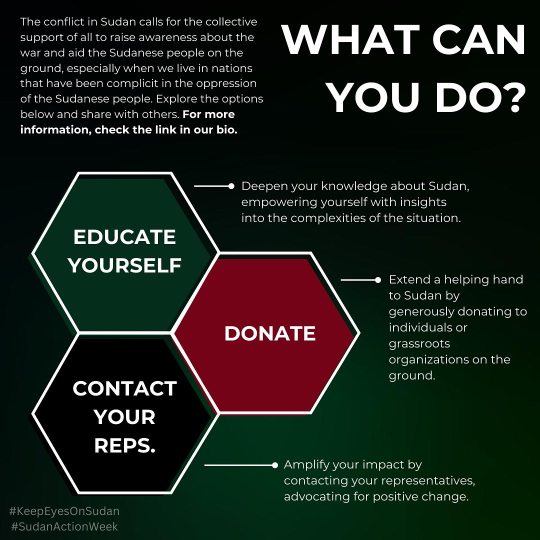
Transcript:
The conflict in Sudan calls for the collective support of all to raise awareness about the war and aid the Sudanese people on the ground, especially when we live in nations that have been complicit in the oppression of the Sudanese people. Explore the options below and share with others. For more information, check the link in our bio.
WHAT CAN YOU DO?
EDUCATE YOURSELF
Deepen your knowledge about Sudan, empowering yourself with insights into the complexities of the situation.
DONATE
Extend a helping hand to Sudan by generously donating to individuals or grassroots organizations on the ground.
CONTACT YOUR REPS.
Amplify your impact by contacting your representatives, advocating for positive change.
#sudan#keep eyes on sudan#KeepEyesOnSudan#Sudan Action Week#SudanActionWeek#i hope the way i formatted it is good#i saw a few hours ago that rsf retreated from wad madani outskirts
370 notes
·
View notes
Text
Landscape helps capture the forms in which nations and movements literally and figuratively 'construct' or 'produce' nature, engineering its appearance and infusing it with significations—rendering landscape a 'cultural practice' rather than a given fact. Here landscape is both an object of investigation and a site of intervention; the very medium within which power and resistance are represented and conducted. Put differently, landscape is far from a neutral backdrop but is rather activated, serving as the medium of violence. Dispossession, deforestation, planting, land-grabbing, and acquisitions, privatization, re-modeling, clearance, or the destruction of infrastructures of life, including food sources, buildings, or supplies, all mobilize the landscape in their domination.
Representations of Middle Eastern and North African landscapes nearly invariably include desolate scenes of endless empty and parched deserts, decorated perhaps with an isolated string of camels, or a beach with large mounds of golden sand, a minaret, or an oil tower in the background. The temporality and general impression of these landscapes is slow, hazy, and dizzying, as if they are waiting for 'activation' by someone or something outside of it. Whether reproduced in academic scholarship, literature, film, tourist advertisements, or news media, these imagined colonial representations of the region's landscape place the environment centrally within them, projecting an understanding of the Middle East and North Africa as marginal, on the edge of ecological viability or as a degraded landscape facing imminent disaster due to human inaction. With this, an environmental imaginary enabled storytelling that pushed forward imperial interests in the name of 'development' and, later, of environmental 'sustainability' and 'protection.' In the case of the constructed 'Middle East,' as Diana K. Davis explains,
"Deforestation narratives have been particularly strong in the Levant region since the nineteenth century, where some of the most emotional accounts of forest destruction have hinged on the presumed widespread destruction of the Lebanese cedar forests illustrated in the cover image by Louis-François Cassas. Similar narratives of overgrazing and desertification were used during the British Mandate in Palestine to justify forestry policies as well as laws aimed at controlling nomads, such as the 1942 Bedouin control ordinance, in the name of curbing overgrazing. Such environmental imaginaries, once constructed, can be extremely tenacious and have surprisingly widespread effects."
In Palestine, the construction of an 'Israeli landscape' to redeem the purported damage done to the land by its indigenous population commenced with the first Zionist settlers in the nineteenth century and intensified with the establishment of the State of Israel in 1948. Reflected in former Prime Minister David Ben Gurion's 1951 public address to the newly formed Israeli Knesset (Parliament):
"We must wrap all the mountains of the country and their slopes in trees, all the hills and stony lands that will not succeed in agriculture, the dunes of the coastal valley, the dry lands of the Negev to the east and south of Baer Sheva, that is to say all of the land of Edom and the Arava until Eilat. We must also plant for security reasons, along all the borders, along all the roads, routes, and paths, around public and military buildings and facilities [ . . . ] We will not be faithful to one of the two central goals of the state—making the wilderness bloom—if we make do with only the needs of the hour [ . . . ] We are a state at the beginning of repairing the corruption of generations, corruption which was done to the nation and corruption which was done to the land."
This 'Israeli landscape' was largely cultivated through the multifaceted and by now well-documented eco-colonial practices of the quasi-governmental Israeli organization, Keren Kayemet L'Yisrael, the Jewish National Fund (JNF), which has since made striking efforts to position Israel as an environmental pioneer. Established in 1901, the JNF may very well be the first transnational environmental nationalist NGO, seeking to 'make the desert bloom' by planting forests, natural reserves, and recreational parks over the ruins of Palestinian villages, holy places, and historical sites. Distinguishing itself from other transnational Zionist organizations, such as the World Zionist Organization and the Jewish Agency, the JNF has since its inception portrayed itself as an environment-oriented nationalist organization, supporting the 'redemption' and 'reclamation' of the land through colonial policies presented in the language of preservation, maintenance, protection, and development of vital ecosystems and ecologically sound environments. Indeed, its public-facing promotional materials boast proudly that "Israel is the only country in the world that entered the twenty-first century with a net gain in the number of trees"—without context, of course, of the ways in which trees and the 'greened' landscape in the country are mobilized as weapons of erasure as part of a colonial imaginary that naturalizes non-Palestinian presence.
Shourideh C. Molavi, Environmental Warfare in Gaza: Colonial Violence and New Landscapes of Resistance
101 notes
·
View notes